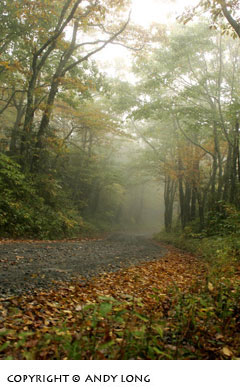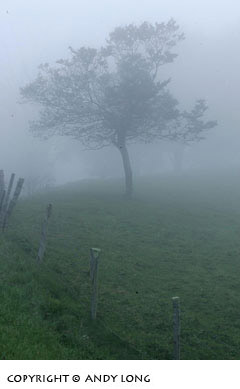Learn what to do when you photo conditions and photo opportunities change.

Creek settings can give you several hours of enjoyment with trying to find all there is to the area.
Your timing is perfect, according to the reports from previous years. You’ve done your research and have planned a photo trip you’ve wanted to take for several years. You make your plane, hotel, and car reservations, and everything is set. You’re filled with excitement, because you’ve heard so many good things about the location. Then it hits you.
You arrive at your destination only to find that–for whatever reason–conditions have changed. The wildflower bloom came early; the fall color is going to be late; or the animal rut is over. Many factors come into play when you’re trying to determine the dates of the peak action.
Typically, you can gauge when the peak season is supposed to happen by the previous years. Weather, however, can mess up the normal schedule. For example, an early freeze can cause fall color to appear ahead of time. On the other hand, an unseasonably warm fall can delay the color a week or two. A very dry, late summer can influence the leaves to turn from green to brown and fall off without much color ever appearing, and a big windstorm can blow all the leaves off–just as they begin turning. Many factors help determine exactly when fall color occurs.
These same factors can also cause peak wildflower bloom to change by a week or two, and an early or late winter can change a rut season by the same amount of time. What can you do when you show up somewhere and the conditions dash your hopes? Switch to Plan B. And then maybe go to Plan C, or Plan D, and so on.
Wherever you go, you can always find something to shoot. Don’t get so depressed that you ruin your trip by deciding the trip is a complete loss and giving up. Use your photographic eye to search out subjects you might not normally be looking for in that spot. Examining an area more closely will turn up a lot more subject matter than you ever thought possible.

Fog can add an air of suspense or mood to shots no matter where you are or what the conditions are like.
When you’re on a wildflower trip, if the great fields of flowers you were expecting are not around, all you need is a handful of individual flowers here and there to make a good shoot. Crawl around on the ground and spend more time on macro work than you previously planned. During a full-flower season, different flowers bloom at different times, so you’ll find something in bloom. In addition, a shortage of subjects can provide an opportunity for you to do some experimentation. When you’re going on a wildflower shoot, take a few extra items along to bring creativity to your shots: a water glass, Mylar, and plastic. Each of these can be used to create abstracts.
If you’re not familiar with Mylar, it’s a very thin, silver, reflective material that can be found at most hobby stores. It’s almost like wrapping paper. With Mylar, you can do several techniques. One is to line a long can (like those in which Pringle’s potato chips are sold) with Mylar and use a wide-angle lens. Set up the lined tube so that the flower-subject is at the base and your lens is at the top. Have the flower in focus, and you’ll have a wash of color along the inside of the tube. Rotating the tube will create different effects. Another trick to do with the Mylar is to lay it on the ground, angled up a bit, and shoot either the Mylar reflection alone or both the reflection and the flower together.
You can shoot through a water glass or plastic to create interesting effects. Like Mylar, an ideal water glass can be purchased at most hobby stores. You’ll be looking for one whose surface is like stained glass but is clear and has different textures to it. It will be made of material that is similar to the glass used for shower doors.
Other effects you can experiment with include zooming and panning a small section of color. Stop all the way down to have a longer shutter speed, and use a telephoto with a wide range. (The effect is best if the lens zooms when you turn the barrel as opposed to when you pull it away from the camera body.) Do numerous zooms back and forth, and you’ll be surprised with the results. You can achieve a similar effect by using a long exposure and panning across a small area. Instead of just doing a straight pan, add a little dip to the movement to add movement to the wash of color.

Let the weather find shots for you such as isolating a lone tree in the fog.
If, when you arrive for a fall color trip, the majority of color has already fallen from the trees, search the ground for interesting compositions. Leaves in streams and on the ground can provide plenty of opportunity. Also, let the weather dictate what you find. If a foggy day presents itself, try to find a single tree set off by itself to isolate in the fog. If you shoot a winding back road as it fades away into the mist, you can create a feeling of suspense. Again, looking at small subjects will provide more opportunities than looking at the larger view. Intimate landscapes of individual leaves can be just as rewarding as a hillside. In fact, if a hillside is barren of leaves except for a few trees, the patterns that can be created by the tree trunks also make interesting compositional studies.
Usually, a fall color trip takes you to the mountains. More often than not, you’ll find water in the area–lakes, rivers, and/or streams. Time spent exploring these areas is time well spent, as water features always provide a couple of hours of shooting, even if at first glance you think there’s not much there. Breaking out small sections, finding reflections or a few leaves in strategic locations, finding a small bit of color to frame an area–all of these discoveries can add up to more photos than anticipated.
The wildlife rut season, while more predictable than wildflower and fall color peak, can fall prey to weather, as well. In fact, wildlife behavior can be a very good indicator of what the winter weather is going to be like in the mountains. If it’s going to be a harsh, early winter, the wildlife will know and could very well conduct their mating season a little early to complete it before the bad weather hits. A mild season can also cause a shift.
Although frustrating, finding subjects other than those you had anticipated can be just as rewarding. The primary animals might not be gathered together for mating, but there should still be some around the area where you can take individual shots in place of interaction and behavior. Other wildlife can provide shooting material, as well. In almost any area in which you can find one type of wildlife, you can also find several other species.
Finally, just because the primary subject you had hoped to shoot is not what was expected, taking time to explore and let your creativity come to the fore will help you both then and on future excursions. Plus, you can plan to come back to the area, knowing exactly what you want the next time.
By Andy Long

Leave a Reply